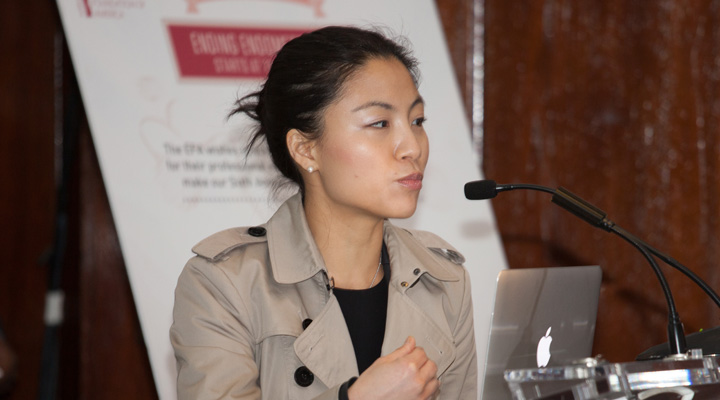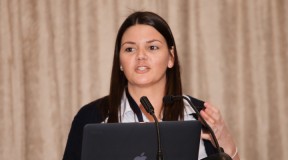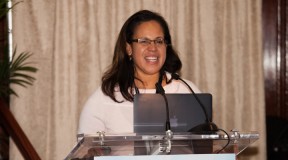Endofound’s Sixth Annual Medical Conference: Ending Endometriosis Starts at the Beginning
What happened to pelvic MRI to detect DIE pre-op? A comparison between the expert versus the general radiologist
Kathy Huang, MD
Thank you for inviting me here to have an opportunity to present our research. We have been looking at MRIs as a diagnostic tool. I started at NYU probably 18 months ago.
Initially, when I first came along we were talking about whether we should use ultrasound. Obviously clinical examination is very important; however, we do not have ultrasonographers that were trained for this and we have an awesome MRI department because our MRI department apparently has been around forever and they have always used…imaging. I started talking to our radiologist because we started to have more and more endometriosis patients and even before I moved to NYU we had several patients who had rectovaginal endometriosis or bowel endometriosis that we did not recognize before surgery so intra-operatively we are finding these lesions. Because I did not consent them for bowel resection or nodule removal we really could not complete it, we had to bring the patients back for a second time, which is really a disadvantage a disservice to our patients. I started talking to our radiologist pretty early on.
We instituted the MRI program for endometriosis. This is just going back looking at the past year, almost two years. This is a retrospective study, we looked at all the patients who underwent MRI endometriosis protocol and we excluded all of those that did not have a complete evaluation, we did not have a follow up, who did not have a surgical evaluation for endometriosis and those people who did not have surgical confirmation. If somebody just went in and let us say just took the scar tissue or ablated the lesions unless we have pathological confirmation of endometriosis we did not include them.
We had a total of 66 patients. This is…MRI technique, which is pretty much a foreign language to me, I do not know of anybody else understand this, but this is what our radiologist does. We also do recto and vaginal contrast gel, which is kind of a pain but now we are used to doing it.
The other reason we wanted to use MRI as opposed to ultrasound is because we thought there may be more inter-observer agreement, meaning we thought that the ultrasounds were so much more operator dependent and hopefully the MRI images, if they are all done in the same way, hopefully people would be more likely to agree, which was not necessarily true but we will go through that.
Basically in the report they talk about whether or not this is elevated posterior fornix , whether or not intestinal tethering, if they saw nodules on the surface of the uterus, whether they would comment on whether or not there is obliterated cul-de-sac, whether or not there is rectovaginal thickening, thickening of the uterosacral ligament, which actually was true a lot of the time and whether or not there was thickening of the mesouterine fold.
This is for our general radiologist. I am sorry that there are just so many things on there that it is so small but basically we looked at the true positives, the false positives, the true negatives and the false negatives. This is for our general radiologist, so this is just the fellows and people who have been looking at the scan, not necessarily the gyn, the pelvic radiologist. Even if they are really good, at least in terms of endometrioma, they are 83 percent sensitive. In the high 80s the specificity is in the 90s. I think they have trouble picking up peritoneal endometriosis although I do not blame them because sometimes those lesions are pretty small. They are really good at picking up urine endometriosis, so adenomyosis essentially. They are not so great at picking up the uterosacral ligaments and they are not great at rectovaginal space, not great at anterior recto wall. This does not look so hot, right but at least they are highly specific. At least if they tell me there is no lesion they are right. Partially it is because I had a few cases if they say there is an obliterated cul-de-sac or they see some narrowing of the lumen then I bring in the colorectal surgeon. I may send the patient to a colorectal surgeon first. We may do the cases together so that if I do run into issues on the bowel that I cannot take care of we do not have to bring the patient back again.
This is from Dr. HeidemannI think some of you guys have met her already at past meetings. Looking at her statistics, she is actually better in some ways and worse in other ways. It does not look like she is too good at picking out bladder endometriosis. She is definitely better in the rectovaginal space, much better than the general radiologist. Overall, I think it ends up being that this is a comparison of accuracy. This is not just sensitivity by specificity. The accuracy is the true negatives plus the true positives over the false negatives and the false positives. They are actually not that different. Overall, they are all 76 percent, which is pretty good. But I think they vary in terms of where they are better. Nicole is much better with rectovaginal space and much better with uterosacral ligaments but I think everybody is pretty good at the endometrioma, which is not that surprising for MRIs. They are both good at bladder, but again, I think Nicole is actually much better in the posterior cul-de-sac which is a lot of times where we worry about.
The other thing I would like to reiterate is your point about going through it systematically because definitely I have seen lesions where sometimes I am still suspicious and I will put in an EA probe and I will see in the posterior fornix where it is actually behind the manipulator, and there are actually small lesions there. Just three weeks ago we did a case that was almost minimal two very, very small lesions in the posterior fornix and I did not even think it was truly positive, it was just faint white. We did resect it and sent it off and it was positive for endometriosis. Sometimes they do not even so the lesions are pretty small they do not necessarily correlate very well with the patient’s symptoms.
Then we did another analysis in terms of inter-observer agreement and we realized that it is really not that great actually even for MRIs. Yes for endometrioma, which I think is not that surprising because that should be the easiest thing to pick up. Not so good for bladder or ureter. Basically it is really only good for endometrioma. The rest, uterine corpus and the fallopian tubes are fair, sigmoid colon is moderate but everything else is not that great. So there are a few things that are going on right now. Since we started this we also started a quarterly meeting in terms that we have a joint conference. I will bring the surgical footage and the radiologist brings the MRI images and we have been going through them. Of course, unofficially, we go back and forth all the time but we actually meet officially every three months. We are gathering that data and we are hoping that with those educational events their inter-observer agreement will go up as well as maybe the sensitivity and specificity will go up, so they understand what I am looking for in surgery and I understand what they are seeing on MRI. Collecting that portion of the data is ongoing. This is just up until we have those meetings. We are going to look at it as what happens after the meetings.
Secondly, we have been doing a lot of MRIs for leiomyosarcoma purposes and inadvertently picking up these endo lesions because now they are so good at picking up these endo lesions. We want to look at it separately, again, whether or not the recto gels and the vaginal gels are absolutely necessary in patient who may not have bowel symptoms. Obviously if people have bowel symptoms they would have a better chance of picking up if we have a higher suspicion then we would do them. But I am wondering whether torturing the patient justifies this, because if we are picking up the endometriosis anyway without those gels then we prefer not to do them. That is the second portion of our study that we are going to look at going forward.
These are some of the images. This patient had a detlef kidney so we removed her kidney, which to me was a little insane. She was the second patient I have seen since I started. Her lesion was around the ureter to the point that it completed compressed it. She had complete obstruction. Her ureter was this big, it looked like that, as you can see it was gigantic.
I think the radiologist told me this is where the lesions were. It actually helped me align the consultation with the patient because the patient had multiple fibroids, something like 18, it was everywhere. She is 43 and her initial intention was just to have a myomectomy. I got the MRI to leiomyosarcoma. It was not even for endo. The results came back that she has an obliterated posterior cul-de-sac and anterior cul-de-sac. We had a very different conversation and we ended up doing a hysterectomy for her for obvious reasons. But we also resected a whole tone of endo, it was a very difficult case. In that setting we really helped her get over – we talked a lot about what we should do, a myomectomy or hysterectomy when she was deciding. Then the fact that we found deep infiltrating endometriosis all over actually really helped her make the decision to go forward with a hysterectomy. This is just our preliminary data and hopefully there will be a lot more to follow. Thank you.
Any questions?
Juan Salgado, MD: Hello, hello Kathy. I am Juan Salgado from Puerto Rico. I do a lot of sonography preparative evaluation for my patients and I trained with Maurice Abräo in Brazil and Calves. And all the data I have been shown between MRI and vaginal sonography with bowel preparation I put in three Fleet enemas it has been very, very good. I think that there are some places that an MRI is the only thing they have because they are more trained. It is dependent the sonography. I had to take my sonographist to Brazil so she would get really, really trained with Manuel and we have very, very good results. We can predict not only the lesions but we can predict the difficulty of the surgery. I can tell my colleagues if this is going to be a very, very difficult surgery. You have a lot of additions, you have lot of lesions that are very, very low, close to the…she is going to need an ileostomy and we can predict everything with that. I am really happy that most gynecologists use preparative evaluation because in the past we did not have these kinds of tools, you just had to go there and see what you can find, and you really did not know what was under the floor. With these types of studies we can really predict what we are going to find and we can help more patients and do less laparoscopy. That is my goal. On complete laparoscopy and do not come back to say I am going to do a bowel resection. If you know it from the previous…you are going to do a disc resection, you are going to do a segmental resection or are you going to do any other surgery, bladder – we can remove all the tissue from the bladder and the patient would know when she wakes up in the recovery room, “I am going to have Foley, I am going to have an ileostomy” and it is not a surprise. Use these tools because they are very helpful and we are doing more studies to do preparative evaluations and we are going to be…very soon. Thank you.
Audience Member: I actually have a comment for you. I have a comment as a patient I was diagnosed at 14. You can imagine the pelvic exams and internal ultrasounds as a young girl added some major trauma to my diagnosis. I really just wanted to say that from a standpoint of your belief of first do no harm that this MRI, the introduction of an MRI versus an ultrasound, I am eternally grateful for and my 14-year-old self very much appreciates the work that you are doing. Thank you.
Kathy Huang, MD: Thank you. You know we often do forget about the teenagers that absolutely we should be using something that is less invasive. Thank you.










